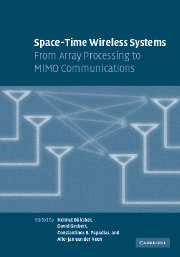Book contents
- Frontmatter
- Contents
- List of contributors
- Acknowledgments
- Introduction
- Part I Multiantenna basics
- Part II Space-time modulation and coding
- Part III Receiver algorithms and parameter estimation
- Part IV System-level issues of multiantenna systems
- 18 MIMO Gaussian multiple access channels
- 19 On information-theoretic aspects of MIMO broadcast channels
- 20 Multiuser MIMO systems
- 21 Opportunistic communication: a system view
- 22 System level performance of MIMO systems
- Part V Implementations, measurements, prototypes, and standards
- Index
19 - On information-theoretic aspects of MIMO broadcast channels
Published online by Cambridge University Press: 25 February 2010
- Frontmatter
- Contents
- List of contributors
- Acknowledgments
- Introduction
- Part I Multiantenna basics
- Part II Space-time modulation and coding
- Part III Receiver algorithms and parameter estimation
- Part IV System-level issues of multiantenna systems
- 18 MIMO Gaussian multiple access channels
- 19 On information-theoretic aspects of MIMO broadcast channels
- 20 Multiuser MIMO systems
- 21 Opportunistic communication: a system view
- 22 System level performance of MIMO systems
- Part V Implementations, measurements, prototypes, and standards
- Index
Summary
Introduction
The broadcast channel (BC) first introduced by Cover (1972) is now a standard channel model in information theory (Cover and Thomas, 1991), which has attracted massive attention, and yet the capacity region is not known in general. The BC models downlink communications, where a central hub (cellsite, for example) transmits to potentially multiple users. Multiple-input multiple-output (MIMO) channels have been identified as a central factor in significantly amplifying the capability of wireless communications (Goldsmith et al., 2003; Tse and Viswanath, 2005). Motivated by practical high reliable rate demands of future wireless and wireline systems, well modeled by the MIMO Gaussian broadcast channel (MIMO GBC), such as cellular systems, wireless local area networks, and xDSL links, the ultimate potential of the MIMO GBC has been identified as a theoretical challenge, which carries evident practical implications.
The central information-theoretic hardship arises in the general MIMO GBC setting, even if all channel state information (CSI) is available at every node (transmitter as well as receivers). This is due to loss of degradation ordering in the general MIMO case, directly leading to the general BC, for which the capacity region is yet unknown. Evidently one may resort to bounding techniques, such as the well known Marton region (Marton, 1979), which constituted for decades the best achievable rate region for the general BC. Different upper bounds are also available, and some of the most interesting are the Marton–Körner (Marton, 1979) and Sato (Sato, 1978) outer bounds.
- Type
- Chapter
- Information
- Space-Time Wireless SystemsFrom Array Processing to MIMO Communications, pp. 385 - 405Publisher: Cambridge University PressPrint publication year: 2006
- 3
- Cited by



